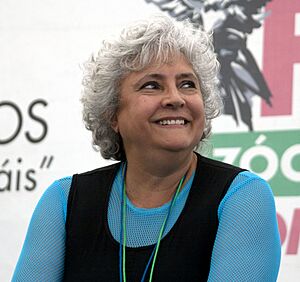Laura Esquivel facts for kids
Quick facts for kids
Laura Esquivel
|
|
|---|---|

Laura Esquivel in Mexico City in 2013
|
|
| Born | 30 September 1950 Cuauhtémoc, Mexico City, Mexico |
| Occupation | Novelist, screenwriter |
| Genre | Magical realism, science fiction |
Laura Beatriz Esquivel Valdés is a famous Mexican writer, screenwriter, and even a politician! She was born on September 30, 1950. Her first book, Like Water for Chocolate, became super popular in Mexico and the United States. It was even made into an award-winning movie!
Laura Esquivel also served in the Mexican Congress for the Morena Party from 2015 to 2018.
Contents
Laura Esquivel's Writing Journey
Laura Esquivel studied Theatre and Dramatic Creation, focusing on plays for children. She also learned about pre-school education and how to lead writing workshops.
Early Career in Television
Between 1970 and 1980, Laura wrote scripts for children's TV shows in Mexico. In 1983, she started a creative center called the Centro de Invención Permanente. Her work in television inspired her to write scripts for movies.
Like Water for Chocolate
This is when she decided to write her famous novel, Like Water for Chocolate, which came out in 1989. It quickly became a huge success!
What is Like Water for Chocolate About?
In her novels, Laura Esquivel uses a style called magical realism. This means she blends everyday life with magical or supernatural events. Her most famous book, Like Water for Chocolate, takes place during the Mexican Revolution in the early 1900s.
The story highlights how important the kitchen and food are in the main character's life. The book is set up like an old-fashioned women's magazine, with each chapter named after a month. Each chapter starts with a traditional Mexican recipe, and the recipe reminds the storyteller of an important event in the main character's life.
Laura Esquivel believes the kitchen is the most important part of a home. She sees it as a place where people learn and find joy. The title Como agua para chocolate (Like Water for Chocolate) is a Mexican saying. It means someone is about to "boil over" with strong emotions, just like water needs to be boiling hot to make Mexican chocolate.
The idea for the book came to Laura while she was cooking her mother's and grandmother's recipes. She even used a story from her own family: her great-aunt Tita was not allowed to marry and spent her life caring for her mother.
Success of the Novel and Film
Even though some critics in Mexico didn't love it at first, Like Water for Chocolate became incredibly popular. It was reprinted many times and became Mexico's bestseller in 1990. The book has been translated into more than 20 languages!
The novel was made into a film that came out in 1992. The movie was a huge hit in the United States, becoming one of the highest-earning foreign films ever. It won many awards in Mexico and nearly two dozen international awards.
Other Novels by Laura Esquivel
- La ley del amor (The Law of Love) (1995): This novel mixes science fiction with a love story. It imagines a future where people work together for the good of the community.
- Between Two Fires (2000): This book is a collection of essays about life, love, and food.
- Tan veloz como el deseo (Swift as Desire) (2001): This story is set in Mexico City. It's about a father and daughter who learn to understand each other better.
- Malinche: novela (Malinche: A Novel) (2006): This book tells the story of Malinalli, also known as Doña Marina, a famous woman from Mexican history. The book's cover even has an Aztec-style picture that looks like Malinalli's diary.
- A Lupita le gusta planchar (2014), translated as Pierced by the Sun (2016).
- El diario de Tita (2016).
Laura Esquivel also helped start a film production company called "Tequila Gang" with famous filmmakers like Guillermo del Toro and Alfonso Cuaron.
Laura Esquivel's Life
Laura Beatriz Esquivel Valdés was the third of four children. Her father, Julio César Esquivel, was a telegraph operator, and her mother, Josefa Valdés, was a homemaker. Her father's death in 1999 inspired her novel Swift as Desire.
Laura first married actor and director Alfonso Arau. They worked together on several films. Today, Laura and her current husband live in Mexico City.
Laura Esquivel in Politics
In 2009, Laura Esquivel ran as a candidate for a local council in Mexico City. In 2015, she was elected to the Mexican Congress for the Morena Party. She also served on committees for culture, science, technology, and the environment.
See also
 In Spanish: Laura Esquivel Valdés para niños
In Spanish: Laura Esquivel Valdés para niños

